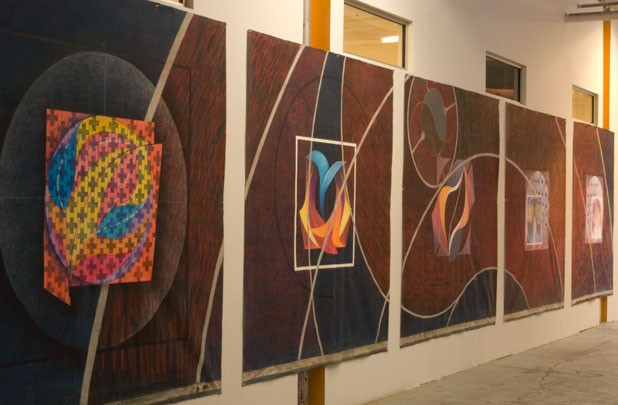
- Matthew Thorsen
- “The David Bohm Quintet: Five Easy Holomove-ments” by Bill Ramage
There are many ways to explain visual insight, and the clichés abound: What you see is what you get; perception is reality; seeing is believing, and so on.
But what if what you see is an illusion?
That’s the way Bill Ramage sees seeing, at least when he has a pencil in hand. Ramage believes his visual perception of the physical world is merely a projection of his mind.
The Castleton State College art professor has been exploring perception in his experimental drawings for 30 years. In his vertiginous abstractions, he superimposes organic forms on both convex and concave grids, forcing the viewer’s eyes to keep tracking back and forth among the intersections of horizontal and vertical lines. Consequently, gazing at one of his drawings is a lot like staring at one of M.C. Escher’s optical illusions for too long: It can be a health hazard. (A viewer once told Ramage she felt dizzy after examining one of his enormous, mind-bending creations.)
Ramage has been discombobulating viewers for years, and his most recent exhibition of drawings at the Flynndog Gallery in Burlington, made almost exclusively with pencil and crayon, proves he hasn’t lost his edge.
The gallery’s long, narrow hallway barely contains Ramage’s abstractions, the largest of which, “The Centripetal Gates of Kiev,” is approximately 8 feet high and 37 feet long. The massive canvas, which Ramage says is an old theater drop, occupies a third of the gallery wall. Cartoonish figures appear in a bluish haze. Above them, a drama plays out in which large red, donut-shaped disks seem to roll purposefully across the canvas. If centripetal force is at work here, it’s operating in reverse, bringing all the elements toward the center, rather than forcing them out to the edge.
Ramage unleashes a similar energy in “The David Bohm Quintet: Five Easy Holomovements.” Here, on a 35-foot-wide canvas, the artist uses layers of grids (“underdrawings”) and finely wrought fields of color (made with carpenter crayons) to convey movement, this time in no particular direction. On this backdrop, Ramage places his jewel-like “hypercubes,” detailed drawings of what look like layers of flower petals — or female sexual organs — within geometric shapes.
In “The Conception,” Ramage flattens the perspective altogether. The grid is reduced to a pair of crosses on a deep blue background — one a T shape, the other an X — which serve as focal points. To further contain the internal action of the drawing, Ramage constrains two comet-like shapes within an invisible circle just inside the 7-foot-square canvas. Crescent-moon shapes outlined in white arc from the center to the outside edge. But the power center of the drawing is actually at the bottom, where one of the comets spins toward three hot-pink lobes that look an awful lot like male genitalia.
While the scale and complexity of Ramage’s artworks are daunting, it’s his evocation of chaos that really intimidates. His drawings engulf and overwhelm the viewer in the way that life circumstances such as illness, death and financial crisis can do. Under his spell, preconceived ideas about order disappear.
Blame it on Einstein and his theory of relativity. Ramage is a student of scientific thought, and his latest readings on physicist David Bohm have taken him to the land of quantum mechanics, where all phenomena are relative to the observer’s position. Ramage has taken this notion to an extreme: His artwork seems to ask viewers to forget everything they know about vanishing points, horizons and the rest. Hello? he seems to say. There is no one linear perspective in contemporary life; the world is full of simultaneously unfolding narratives from different points of view. Get used to it.
It’s hard to believe that Ramage started out as a representational portraitist and sculptor. The artist says he was in the middle of a self-portrait (part of his “empirical phase”) when he stopped cold and realized he wanted to create abstractions — to apply what he’d discovered about the nature of the mind’s eye and how it projects its own perceptions on the real world.
Ramage, who is disarmingly frank, has charted the trajectory of his career on his website. We recommend the trip down his virtual lane, and a reality check at Flynndog. You’ll believe it when you see it.









Comments
Comments are closed.
From 2014-2020, Seven Days allowed readers to comment on all stories posted on our website. While we've appreciated the suggestions and insights, right now Seven Days is prioritizing our core mission — producing high-quality, responsible local journalism — over moderating online debates between readers.
To criticize, correct or praise our reporting, please send us a letter to the editor or send us a tip. We’ll check it out and report the results.
Online comments may return when we have better tech tools for managing them. Thanks for reading.